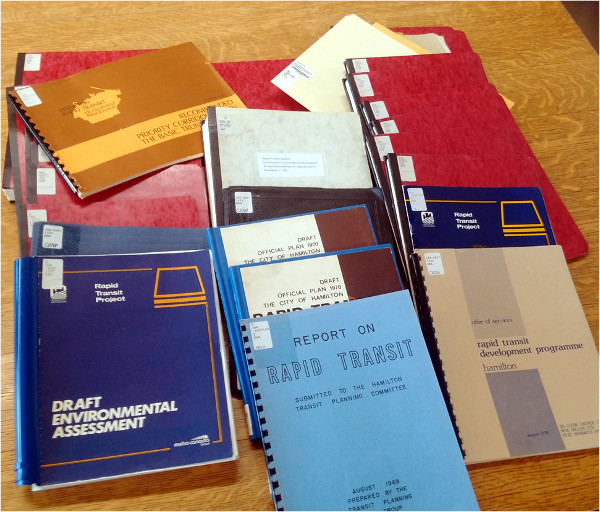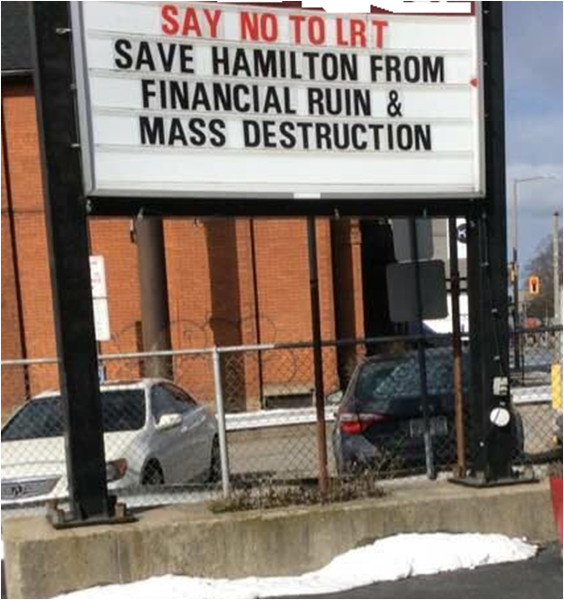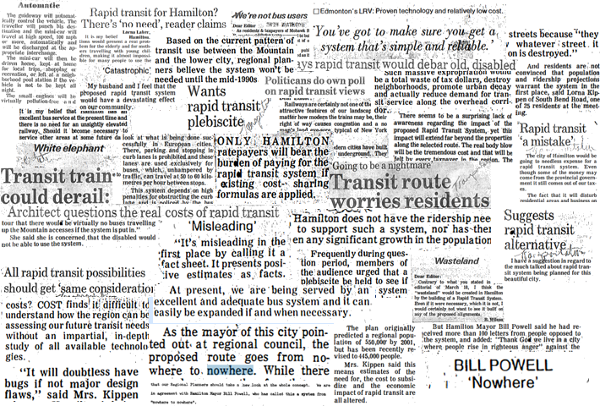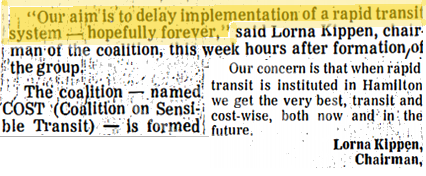The last 'Coalition On Sensible Transit' organized to kill LRT and then disappeared for 35 years without advancing any of alternatives or improvements they had used to kill the plan.
By Karl Andrus
Published April 03, 2017
During this precarious point in Hamilton's LRT project, I would like to review the history of Hamilton's past rapid transit debates.
Over last summer, I researched and submitted to City Council a comprehensive review of the history of rapid transit in this city. It provides a good historical context for the current discussion around Rapid Transit.

Decades of failed rapid transit plans since the 1960s
Why is this history important? If we learn it, perhaps we can avoid repeating the mistakes of the past. Over the last 50+ years, Rapid Transit has been studied to death. There have been dozens of studies on the topic.
We as a community have long understood the extensive need. In the last ten years, additional time and money has been approved and spent on further study and implementation. A natural procedural course of those studies is the Environment Project Report amendment Council is suddenly afraid to approve.
In previous requests for funding rapid transit, we have never gotten a commitment from any level of government to consider a fully-funded rapid transit project. 100 percent Full Capital funding. This is not just a once-in-a-generation opportunity, it is once-in-a-lifetime!
Consider:
In October 1971, responding to the city's request, the Province promised funding of $238 million ($1.45 billion in 2016 dollars) for 28 km of rapid transit, linking Mohawk Road at Upper James with Burlington Street through downtown. Another line was to run from Mount Albion Road to Highway 2 and Main Street in the West. This plan would have been funded 75 percent from Ontario Government and 25 percent from the Local/Regional Government.
In December 1981, an elevated Intermediate Capacity Transit System was proposed to run from Downtown to the Mountain. $111 million ($285,270,000 in 2016 dollars) 45 percent funding from Ontario Government, 45 percent funding from the Federal government and 10 percent from the local/regional government. (This technology was later installed in Vancouver as SkyTrain and is still running to this day.)
In February 2013, Council approved asking the Government of Ontario to fund a full B-Line LRT at a cost of $875,183,183.61 (in 2016 dollars), as long as the Province agreed to cover 100 percent of the capital cost.
Two years later, in May 2015, the Ontario Government committed to full capital funding - 100 percent - for Scenario D in the City's funding request: McMaster to Queenston Traffic Circle, the second-best option approved by City Council. (Rapid Ready - Expanding Mobility Choices in Hamilton (PW13014))
The money is coming from the Moving Ontario Forward fund and will be returned to the fund to be used in other projects if we do not use it. Other cities have already expressed interest in Hamilton's rapid transit money if we turn it down.
This is not theoretical: it has already happened to Brampton, which turned down their LRT project at the last minute. In a narrow 6-5 vote, Brampton Council rejected the HMLRT. Some of the six Councillors were of the belief that a better alternative route is out there and they could still use the money for it.
That city has to fund the development of its new rapid transit plan from local tax dollars and won't have another transit plan ready even to submit for funding consideration until at least 2020.
The argument that we can just do something else with the cash is simply false. If history doesn't convince you then how about the modern discussion?
Now, I understand the fear such a massive project can bring on local businesses. Change can be scary, especially when you feel your livelihood could be on the line.

'Say No To LRT' sign
The misinformation being spread by project opponents could fill anyone with an apocalyptic fear. Doomsday scenarios are common among those most strongly opposed to the current and previous Rapid Transit Project.
It turns out that in Kitchener-Waterloo, the construction of LRT did not live up to the doom and gloom forecasts. The Uptown Waterloo BIA reported only two member businesses that closed due to construction.
"Was there fear and frustration? There was when construction started (in 2014)," said Patti Brooks, executive director of the 450-member Uptown Waterloo Business Improvement Area. "One hundred percent of the kudos go to our businesses for doing what they needed to do."
In the end, she says, "We only had two businesses that closed due to construction."
Meanwhile, dozens of new businesses have opened aong the line and major new developments are underway.
Of the thousands of business along the KW LRT, only a small number have filed a lawsuit claiming any kind of loss or damages to their business.
Coupled with the experiences Hamilton has learned from the recent Concession Street reconstruction and the goodwill and support of local community organizations who wish to help shop along the corridor during construction - like the Stinson Community Association, which is committed to support our local BIAs and businesses during LRT construction - I believe the hysterical fear, while understandable, is not justified.
Speaking of fear, justified or otherwise, here is a sampling of clippings from newspapers in Hamilton during the last Rapid Transit debate. I have pasted clips mostly from civic politicians and members of the group opposed to the last RT project.

News clippings from previous rapid transit debate
Notice the many similarities in the tone and phrasing of the opposition. While often the points are coached in valid or semi-valid questions, they are commonly used disingenuously to fan the flames. Legitimate concerns are frequently manipulated to disrupt and disengage rather than inform and contribute.
Think about the irony of people opposed to this new project project reviving the "Coalition on Sensible Transit" brand. In the last rapid transit debate, that group established themselves as a bunch of concerned citizens trying to propose what-ifs and why-nots around a sure thing.
Also ironically, the group that garnered so much support because they wanted to champion better public transit, more buses, ask the tough questions, propose alternative technologies and transportation methods ended up accomplishing none of them.

Mission accomplished?
None of the alternative technologies or routes or routes propsed during the last debate were ever implemented or even seriously advocated. Instead, the HSR has experienced a long, steady and catastrophic decline in inflation-adjusted spending and ridership without a peep from the "Coalition On Sensible Transit".
The group continued to be active in the historical record to oppose another intercity Rapid Transit project called GO-ALRT, and then disappeared altogether, from what I could find in the newspaper clippings after that project's demise.
It now appears another generation has resurrected the same name to accomplish the same thing the last group did: "delay rapid transit..forever"
By kental (registered) | Posted April 03, 2017 at 20:06:34
It appears to me that there is a mostly geographical divide this time. The councillors who are in favor are located in the suburban and rural areas. And their go-to excuse is they're scared the operating costs will be too high.
There is a simple solution which short-circuits their excuse though:
Make a special tax zone within ~1km radius of the LRT line. If the per-ride subsidy of LRT does end up being higher than the per-ride subsidy of HSR Bus, then that difference should only be paid by those within the special tax zone.
That really pulls the carpet out from under the opposing councillors soapbox.
By rednic (registered) | Posted April 03, 2017 at 20:41:15 in reply to Comment 121056
Great idea my property taxes increase based on greater value and then i'm applied a surtax because the goverment cant estimate.
So in effect what your saying is every project in the lower city must be back stopped by lower city taxpayers but projects like this http://judipartridge.ca/mto-highway-5-6-... will receive full city funding? You have a figure on what the the maintenance for that is ? Perhaps you don't care because you believe urban sprawl on to farm land is cool.
By kental (registered) | Posted April 03, 2017 at 21:44:01 in reply to Comment 121057
"Perhaps you don't care because you believe urban sprawl on to farm land is cool."
Well that escalated quickly.
If you own land near the LRT, you will be benefiting from a land value uplift. That's wealth into your pocket. That's why I strongly support it.
Personally, I don't expect that the LRT would be a money black hole, so I predict the tax increase on the zone will be negligible, if anything at all.
Maybe you disagree and think it will be a huge ongoing expense. And maybe you're right. And if you believe that, then you should be against the LRT.
But expecting somebody who lives in Waterdown to be interested in chipping in is kinda petty. They have no more interest in it than somebody in Burlington.
Comment edited by kental on 2017-04-03 21:44:16
By kevlahan (registered) | Posted April 04, 2017 at 05:39:23 in reply to Comment 121060
Note that property tax automatically accounts for relative increases in land value: if property values along the line increase faster than in other area the proportion of Hamilton property tax paid by those living near the line automatically increases. They will contribute more taxes. There is no need for other mechanisms.
As Ryan points out, big road infrastructure projects have both their capital costs and operating costs paid equally by all residents.
In contrast, in the case of LRT the capital cost is being paid entirely by the Province (which means a very small portion paid by Hamilton residents via provincial taxes, about 4%). As for operating costs, unlike roads, LRT riders actually pay a user fee which off-sets the costs. And because of its high capacity, unlike buses, the more people ride LRT the lower the net operating cost. People forget that just snow-clearing for RHVP and LIncoln Alexander parkway cost several million dollars per year. I don't recall operating costs being an issue at all for RHVP.
Comment edited by kevlahan on 2017-04-04 05:41:16
By kental (registered) | Posted April 04, 2017 at 09:19:22 in reply to Comment 121063
Note that property tax automatically accounts for relative increases in land value
Excellent point. If this is taken into account in the calculation, it would make my proposal even better.
I believe this is called tax increment financing. The importantpart part (for the suburbanites), is that it would not affect their tax in the bs scenario where lrt is a money pit.
By KevinLove (registered) | Posted April 03, 2017 at 21:02:39 in reply to Comment 121057
In general, the cost of servicing suburban households is far higher than urban households. In Halifax, the average cost to the City of servicing a suburban household is $3,462 and for an urban household it is $1,416. Less than half. I suspect that the ratio in Hamilton would be about the same.
I would have no problem with receiving an "urban density property tax rebate" to compensate for the lower costs of servicing my home.
By VivSaunders (registered) | Posted April 04, 2017 at 06:38:24
Just to piggy back on Kevlahan's excellent point, when it comes to transit all Hamilton residents, both urban and rural, pay for the capital costs of our HSR buses. The funding by the Province to pay for the capital costs of LRT is certainly a benefit for every Hamiltonian. Near as I can figure, that's 10 years of replacement buses we no longer have to purchase for the BLine.
When it comes to the operating costs of HSR city-wide, Ward 15 (parts of Waterdown only) pays 1.4%, Ward 15 west of Parkside Drive in Waterdown and Ward 14 pays zero, Wards 9,10&11 (Stoney Creek) pay 6.45%, Ward 12 pays 4.38%, Ward 13 pays 2.08% and Ward 11 (Glanbrook only) pays 2.32%. Wards 1 to 8 pay the balance of the 83.38% of our public transit operating costs.
We already have a "special tax zone" imo.
By kental (registered) | Posted April 04, 2017 at 09:25:21 in reply to Comment 121064
The funding by the Province to pay for the capital costs of LRT is certainly a benefit for every Hamiltonian.
That's true. Which is a great reason for the councillors from across the city to support it. But it doesn't appear to have been the clincher quite yet.
I think the lrt would be such a boon to the residents and property owners nearby, that they should be happy to pay what little more tax (probably 0) it takes to run it.
If you're more interested in "sticking it" to people 20km away for spite? Then I guess you won't...
By mountain66 (registered) | Posted April 04, 2017 at 11:21:52 in reply to Comment 121067
To be truthful I don't feel qualified to make a decision one way or another on LRT. As we would say at work "This project is beyond my realm of expertise." Any councillor asking for a referendum is doing exactly that, while I feel I have kept up with the various arguments I am in no way an expert who should be making a decision on a $1 Billion project. With shamefully low voter turnout in Municipal elections, that is what you would be asked to do. In my opinion the "No-LRT" Councillors have failed to present an option and failed to tell their constituents what they would do instead (if anything). Instead they chose to simply oppose. ●If BRT is their option, would they acknowledge that to be true BRT it would need dedicated lanes? ●Why did they vote for LRT if they wanted BRT instead of LRT? Simply raise the arguments then they are using now. I am not buying for a minute they just found out now. ●If they support dedicated lanes for BRT, why did they vote against the bus lane experiment? ●Would they consider HOV lanes, like used in Toronto, where motorcycles and cars with more than 3 people share the lane with buses?
●If they support BLAST, which included exactly the A line route recently proposed, why do they oppose the A line now?
●What would the operating costs of BRT?
●It has been known for some time that the proposed route would end at the Queenston traffic Circle. Why did they not withdraw support as soon as this was announced?
● Would they support LRT if B-line were extended back to Eastgate (which was the original proposal they supported) and funded by eliminating A-line BRT?
● Given that nowhere in the world has privatization resulted in lower rates and that the overwhelming majority of the voters in Ontario are opposed to the privatization of Hydro One, if you oppose LRT would they favour using having the Wynne government using the $1 Billion to buy back Hydro One shares? Even in the best case scenario LRT would only benefit Hamilton, while restoring Public power would benefit every rate payer from Atikokan to Zurich. They could then fund the project with the up to $500 million revenue Hydro One pays the province every year.
Comment edited by mountain66 on 2017-04-04 11:22:40
By JasonL (registered) | Posted April 04, 2017 at 10:06:24
one major difference between now and 1981 is our $3 billion infrastructure deficit. The usual opponents of change back then proudly proclaimed that everything is just fine, we don't need this.
Well, they've been in charge and have had their way 36 years and guess what: their way doesn't work. in a mere 3 decades their do-nothing vision has buried us in a massive financial hole with business as usual development and horrendous city-building practices followed by almost nobody anymore around the world.
Perhaps we could be excused for buying some of their bunk in 1981. But anyone who defends the status quo, despite it's dire results, here in 2017 has no business being in public office.
This is great, Karl. There is something to be said about going through our history and archives at the HPL. I did the same during the Stadium Debate and it's amazing how history repeats itself.
What's that little 'voice' in this debate saying 'keep it where it is' that we might end up with if we are not careful? If we would have fully explored/dispelled that option last time, we wouldn't be where we are.
Explore the undesirable deeply.
https://drive.google.com/file/d/0B7o6d7R...
Comment edited by lawrence on 2017-04-04 14:14:08
By KarlAndrus (registered) | Posted April 04, 2017 at 23:03:15
Well I did enjoy both visits to dive into the archives to review this history, I am shocked at how easily a major trans-formative project like this can be hijacked by those opposed to change. Hamilton stands on a razors edge of rebirth. Moving from our industrial roots into a more modern service and idea based economy. We have a chance to join cities like Waterloo in attracting world class employers, creating future proof jobs and new kinds of industry. The alternative is really to stay stuck in the past. Cling to the hope that classic heavy industry will return to the city and that climate change is actually a myth. To the idea that we can continue to keep tax increases low, not reinvest in the core infrastructure and just keep squeezing savings out of an already over burdened public sector. All while maintaining the same service levels. That is hardly an attitude that is forward looking or a model for growth.
You must be logged in to comment.
There are no upcoming events right now.
Why not post one?